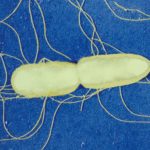Link to Pubmed [PMID] – 17307773
J. Antimicrob. Chemother. 2007 Apr;59(4):751-4
OBJECTIVES: To detect the qnrA, qnrB and qnrS genes among Salmonella isolates received at the French National Reference Centre for Salmonella in Paris, France.
METHODS: Antibiotic susceptibility was determined by disc diffusion for 499 Salmonella isolates including 320 Salmonella Typhimurium, 100 Salmonella Enteritidis and 79 Salmonella Hadar collected in 2002. Amplification with specific primers of qnrA, qnrB and qnrS genes was performed for all Salmonella Typhimurium, Salmonella Enteritidis and Salmonella Hadar isolates resistant to quinolones and for 17 additional isolates that produced expanded-spectrum beta-lactamases (ESBLs).
RESULTS: Prevalence of quinolone resistance was 3.75%, 11% and 79.7% for Salmonella Typhimurium, Salmonella Enteritidis and Salmonella Hadar serovars, respectively. A single isolate (0.2%) was qnrA-positive (QnrA1 determinant) being a Salmonella serovar Concord carrying also the ESBL gene bla(CTX-M-15). This strain was probably from East Africa. No qnrB or qnrS genes were identified.
CONCLUSIONS: Whereas plasmid-mediated quinolone resistance of the Qnr type is emerging in Enterobacteriaceae worldwide, it remains rare in Salmonella in France.



